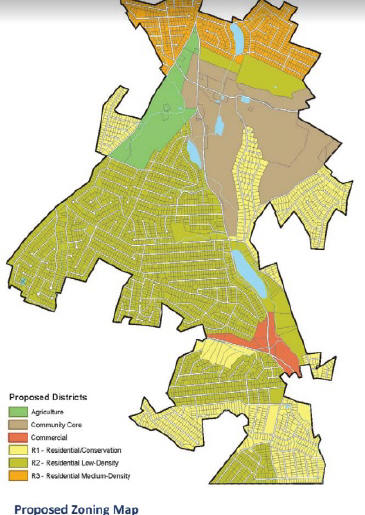 (10/1)
On September 18th, Carroll Valley’s Planning Commission held an open house at
the borough building to discuss the newly proposed zoning plan for Carroll
Valley. The revisions to the zoning ordinance have been years in the making,
with hard work set forth by the Planning Commission members. Residents of the
borough and property owners were invited to attend the open house in order to
learn more about the proposed zoning changes as well as ask zoning related
questions.
(10/1)
On September 18th, Carroll Valley’s Planning Commission held an open house at
the borough building to discuss the newly proposed zoning plan for Carroll
Valley. The revisions to the zoning ordinance have been years in the making,
with hard work set forth by the Planning Commission members. Residents of the
borough and property owners were invited to attend the open house in order to
learn more about the proposed zoning changes as well as ask zoning related
questions.
The borough’s current zoning ordinance was adopted back in 1976, meaning it has
been nearly 43 years since any changes were made to the existing ordinance. The
Planning Commission hopes that the newly proposed zoning ordinance will be more
user friendly while meeting both the current and future needs of the borough
and its residents.
The overarching goal of these revisions is to accomplish four key objectives.
The new changes hope to: protect individual property owners from harmful or
undesirable uses of adjacent properties; correct inconsistencies throughout the
code from previous revisions; assist economic growth by helping to reserve
adequate and desirable sites for commercial uses; and provide an orderly and
systematic transition in land use that benefits all property owners throughout
the borough.
There are three main changes proposed in the revised zoning ordinance. Firstly,
the new ordinance utilizes three types of Residential Zoning Districts, which
reflect the different types of neighborhood characteristics that have developed
over the past 43 years. Within the current zoning ordinance these three
residential areas all fall within the same zoning district, but will now be
separated into three separate entities. These separate districts will be: R1
Residential/Conservation, R2 Residential Low Density, and R3 Residential Medium
Density.
The second proposed change would allow for the simplification of the Commercial
District that is located near the Rt. 116/Rt. 16 intersection. As it currently
stands, there are two different types of commercial districts in this area with
different sets of rules for each. A simplification of rules and the division
within the Commercial District will be revised.
Lastly, the new ordinance includes the creation of a Community Core District
located at the Rt. 116/Sanders Road intersection. The Community Core District
will be classified as a multi-use district and is intended to provide an area
that would permit uses that may complement the nearby existing
commercial-recreational uses through several ways. It is the hope that this new
district will provide a mixture of neighborhood serving non-residential
functions clustered closely together as well as provide a zoning district with
higher density residential options to ensure that development occurring within
this particular zoning district is of a scale and design that enables a variety
of transportation modes to be used. Additionally, this new district hopes to
promote the development of an internal street system that focuses on local
travel and connectivity between developed sites rather than accommodating
higher velocity thru traffic while encouraging property design that focuses on
building design, placement and pedestrian scale. Planning Commission members
also hope that this new district will help encourage a consistent architectural
approach that is both reflective of and enhances the existing Carroll Valley
community.
Each zoning district will have new individualized site requirements, such as
building setbacks, impervious area maximums, and lot size, all based upon the
character of the neighborhood. Permitted uses within each district, although
similar to the existing ordinance, have been modified to reflect the character
of each neighborhood/zoning district.
Residents of the borough should not expect to see any changes to their
property’s tax assessment if the zoning changes are accepted. As described, the
tax assessment is based upon the use of the property as opposed to the zoning
district in which it is located. Additionally, if the property’s use is already
established before the zoning changes are made, and the use is allowed under
the old/current zoning, it will be grandfathered in and will be permitted to
continue.
The newly revised zoning ordinance must come before Borough Council for
approval. Further news regarding this topic will follow in future editions.